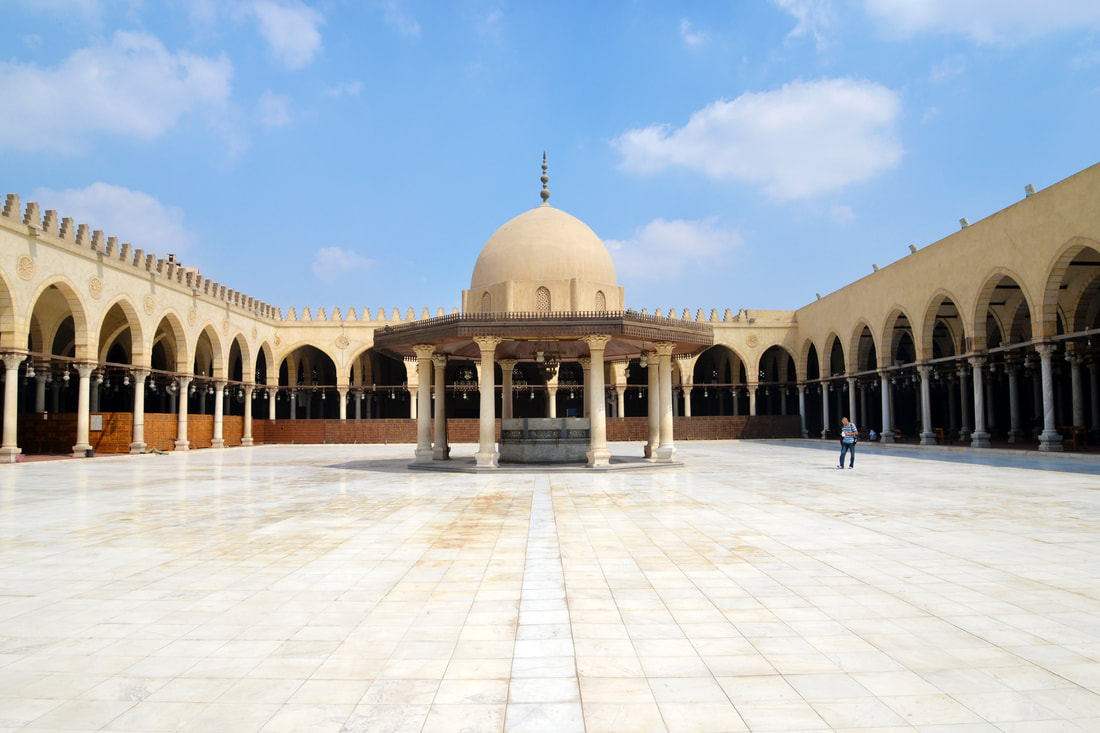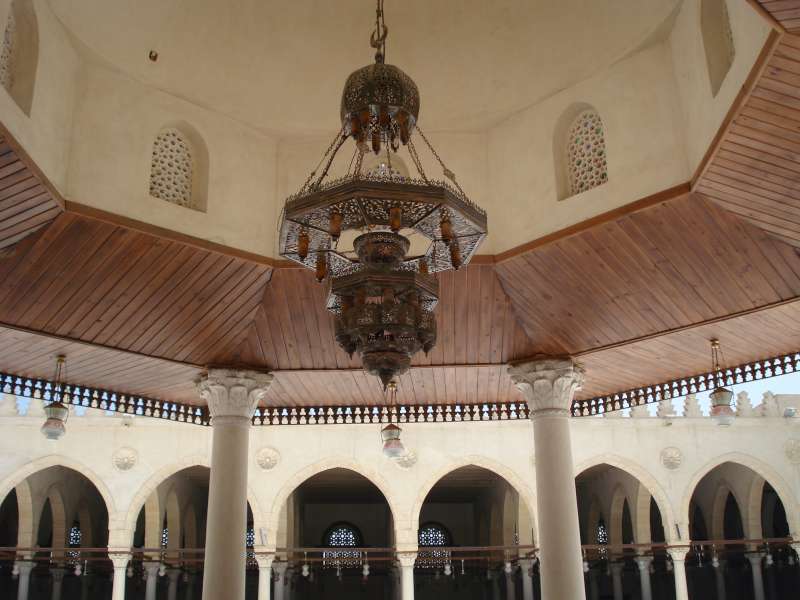Cairo's Architectural Jewel: Unveil Amr Ibn Al-A'As Mosque Beauty

Hello there! It's great to have you reading about the beauty of Cairo's architectural gems. In this article, we will talk about the Amr Ibn Al-A'As Mosque and its significance. You'll learn about the mosque's rich history and why it's worth visiting. We'll also discuss why showcasing the beauty of these stunning structures is essential.
Overview of the Amr Ibn Al-A'As Mosque and its historical significance
The Amr Ibn Al-A'As Mosque is the oldest mosque in Egypt and one of the most critical Islamic landmarks in Cairo. It was built in 642 AD in just two years by the Muslim commander Amr Ibn Al-A'As, who was the conqueror of Egypt.
The mosque played a crucial role in Islamic history as it was the first place where Friday prayers were held in Egypt. The mosque underwent many transformations over the years but still holds significance in Egypt's religious history. The mosque's architecture was originally simple but beautiful. Its unique construction using mud bricks and its use of natural light made it stand out.
Importance of showcasing the beauty of Cairo's architectural gems
Cairo boasts some of the world's most beautiful and impressive Islamic architectural marvels. They provide insight into the city's fascinating history and are a source of national pride for Egyptians. It is only right that we showcase these architectural gems to preserve them and promote and celebrate Egypt's rich cultural heritage.
Egypt is one of the top tourist destinations, and showcasing the beauty of Cairo's architectural gems can attract more visitors and boost the country's economy. It's essential to ensure that the sites are well-maintained, visitors are guided appropriately, and the necessary security measures are in place to protect them.
The Amr Ibn Al-A'As Mosque is essential to Egypt's religious history and showcases the country's architectural mastery. It's vital to preserve and showcase the beauty of Cairo's architectural gems for cultural heritage and as a tourism booster.
History of the Amr Ibn Al-A'As Mosque
Origins of the mosque and its evolution
As mentioned, the Amr Ibn Al-A'As Mosque was built in just two years, making it the oldest mosque in Egypt. The mosque's origins are traced back to 642 AD, when Amr Ibn Al-A'As, the Muslim conqueror of Egypt, ordered its construction.
Initially, the mosque was simple but elegant, constructed using mud bricks and plaster. The mosque underwent several transformations over the centuries, especially during the reigns of various caliphs. The mosque's original shape was a rectangle with a flat roof, an open courtyard, and a rectangular prayer hall. In the 13th century, the mosque was rebuilt with a dome covering the prayer hall, giving it a more modern and sophisticated look. The mosque has undergone several renovations to preserve its structure and heritage.
Significance of the mosque in Islamic history
The Amr Ibn Al-A'As Mosque played a crucial role in Islamic history, specifically in Egypt's Islamic heritage. It was the first place where Friday prayers were offered in Egypt, and it served as a centre of Islamic learning for centuries. It was also used by the Fatimid rulers as a royal mosque, lending it royal significance. Because of its rich history and cultural heritage, the mosque represents a crucial historical landmark for Islamic architecture.
The Amr Ibn Al-A'As Mosque represents an essential part of Cairo's cultural heritage and is a historical landmark of Islamic architecture. The mosque's entry is free, and visitors can see its beautiful architecture sophisticated interior design, and learn about its rich history. It is imperative to preserve the beauty of Cairo's architectural gems to promote Egypt's cultural heritage and attract more tourists to boost its economy.

Exterior Architecture and Design
Overview of the Mosque's Overall Exterior Design
The Amr Ibn Al-A'As Mosque's exterior design is beautifully crafted with intricate details and carved reliefs. The mosque has a traditional Islamic architectural style featuring symmetrical courtyards with ablution fountains and a pointed arch entrance. The mosque's spacious grounds provide a serene and contemplative atmosphere, inviting visitors to reflect on their spiritual journey.
Detailed Look at the Mosque's Façade and Minaret
The mosque's main entrance features a horseshoe arch with a decorated niche framed rectangular. The facade is adorned with intricate geometric patterns and calligraphy. Meanwhile, the minaret on the mosque's southeastern corner stands tall at about forty-eight meters and has three balconies with various decorative patterns.
Significance of the Mosque in Islamic History
The Amr Ibn Al-A'As Mosque is essential in Islamic history, specifically Egypt's Islamic heritage. It was the first mosque in Egypt where Friday prayers were offered and had been a centre of Islamic learning for centuries. As a royal mosque, it held significant importance to the Fatimid rulers. The mosque is a critical landmark in Islamic architecture's history and integral to Cairo's cultural heritage.
Now that you know more about the Amr Ibn Al-A'As Mosque, visit this historical landmark and marvel at its impressive architecture and rich history. Entrance is free, and guides are available to explain the mosque's intricate details.

Interior Architecture and Design
Overview of the Mosque's Interior Design
Entering the Amr Ibn Al-A'As Mosque, you'll be captivated by the intricate patterns and designs adorning its walls and pillars. The mosque's interior design features traditional Islamic motifs and Arabic calligraphy, complemented by soothing natural colours. The spacious courtyard forms the centre of the mosque, surrounded by covered galleries.
Detailed Look at the Mosque's Prayer Hall and Mihrab
The mosque's prayer hall boasts a majestic dome, creating an illusion of vast space. The walls are adorned with intricate carvings and geometric patterns. The mihrab, a niche in the wall indicating the direction of Mecca, is decorated in stunning blue and gold hues.
Now that you know more about the Amr Ibn Al-A'As Mosque, it's time to visit this historical landmark and marvel at its impressive architecture and rich history. Entrance is free, and guides are available to explain the mosque's intricate details.

Restoration Efforts
Overview of recent restoration efforts on the mosque
Over the years, the Amr Ibn Al-A'As Mosque suffered from wear and tear due to natural causes and environmental pollution. As a result, in 2008, the Egyptian government initiated restoration efforts to conserve this valuable piece of history. The restoration process included repairing cracks and damage to the structure, replacing wooden elements, and addressing the issue of water leaks. The restoration efforts didn't compromise the mosque's unique design and architectural elements.
Importance of preserving Cairo's architectural heritage
Preserving Cairo's architectural heritage, including old and historical buildings and mosques, is crucial for maintaining the city's rich cultural legacy. Historical buildings allow us to connect with our past and understand our ancestors' way of life. This is especially true in a city like Cairo, where history is intertwined with architecture.
The restoration efforts on the Amr Ibn Al-A'As Mosque are a testament to the city's commitment to preserving its cultural heritage. These restoration efforts add immense value to Cairo as a city, both as a tourist attraction and socially. By preserving these treasures, we honour our past and ensure that future generations can do the same.

Visitor Experience
Tips for visitors to the Amr Ibn Al-A'As Mosque
- Wear modest and respectful clothing that covers your knees and shoulders.
- Remove your shoes before entering the mosque as a sign of respect.
- Avoid visiting during prayer times as the mosque is closed to visitors.
- Take a guided tour, if possible, to get a better understanding of the mosque's history and significance.
Suggestions for experiencing the mosque's beauty
As you explore the mosque, please take a moment to admire its architectural beauty and intricate details. Pay attention to the patterns and designs on the walls and ceilings. Here are some suggestions to enrich your visit:
| Experience | Description |
|---|---|
| Take in the view from the terrace | Head up to the rooftop terrace for a panoramic view of the mosque and the surrounding area. |
| Listen to the call to prayer | Whether you're inside or outside the mosque, take a moment to listen to the call to prayer and experience this sacred ritual. |
| Visit the museum | Explore the museum inside the mosque to learn more about its history and the restoration process. |
| Join a walking tour | Consider joining a walking tour of Islamic Cairo to learn more about the area's history and explore other mosques and landmarks nearby. |
Enjoy your visit to the Amr Ibn Al-A'As Mosque, and take the time to appreciate this significant historical and cultural treasure!

Impact on Cairo Tourism
Role of the Amr Ibn Al-A'As Mosque in promoting tourism in Cairo
- The Amr Ibn Al-A'As Mosque is the oldest in Africa, which provides tourists a unique opportunity to witness the beginning of Islam in Africa.
- The mosque is a popular destination for Muslim pilgrims, particularly during the holy month of Ramadan.
- The mosque's historical and architectural significance attracts tourists interested in Islamic art and architecture.
- The mosque's location in the heart of Old Cairo allows visitors to explore nearby landmarks, such as the Hanging Church and Ben Ezra synagogue.
Potential for other architectural gems to attract visitors to the city
Cairo is home to numerous architectural gems that have the potential to attract visitors and contribute to the city's tourism industry.
| Architectural Gem | Description |
|---|---|
| The Great Pyramid of Giza | The only surviving monument of the original Seven Wonders of the World, the Great Pyramid of Giza is a must-visit for tourists interested in ancient Egyptian history. |
| The Saladin Citadel of Cairo | A medieval Islamic fortification located on Mokattam hill overlooking the city, this fortress is an example of medieval Islamic military architecture. |
| The Al-Rifa'i Mosque | A historic mosque located in the heart of Cairo with impressive Ottoman-style architecture and intricate tile work. |
| The Egyptian Museum | The Egyptian Museum is home to thousands of artefacts, including the famous Tutankhamun collection, and offers tourists a chance to learn about Egypt's rich history and culture. |
Cairo offers visitors much to see and experience, from architectural wonders to ancient artefacts and religious monuments. Tourism is a key sector of Egypt's economy, and preserving these gems for future generations will help to ensure a continuous flow of interested tourists. So why not plan your next trip to Cairo and discover the beauty of this ancient city?
